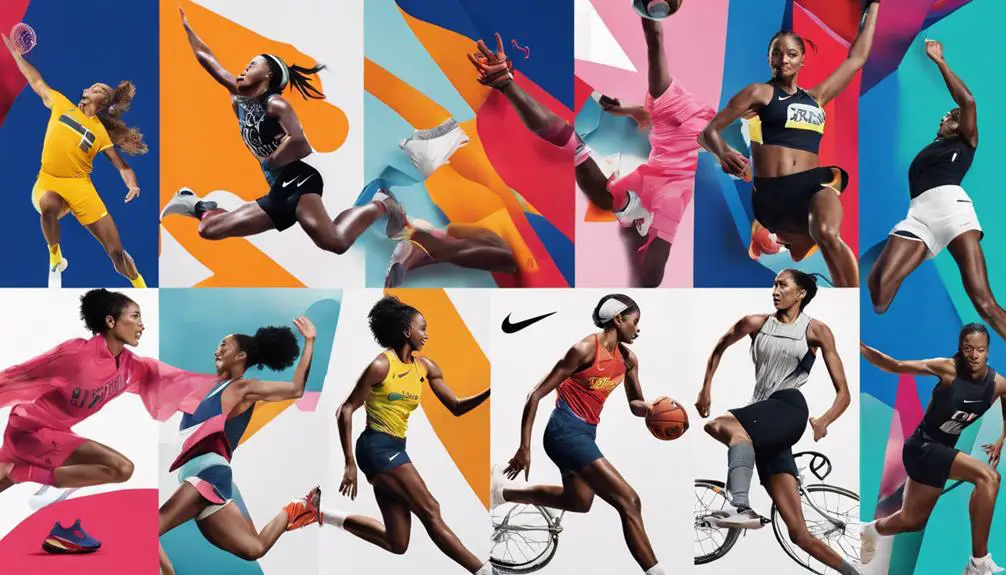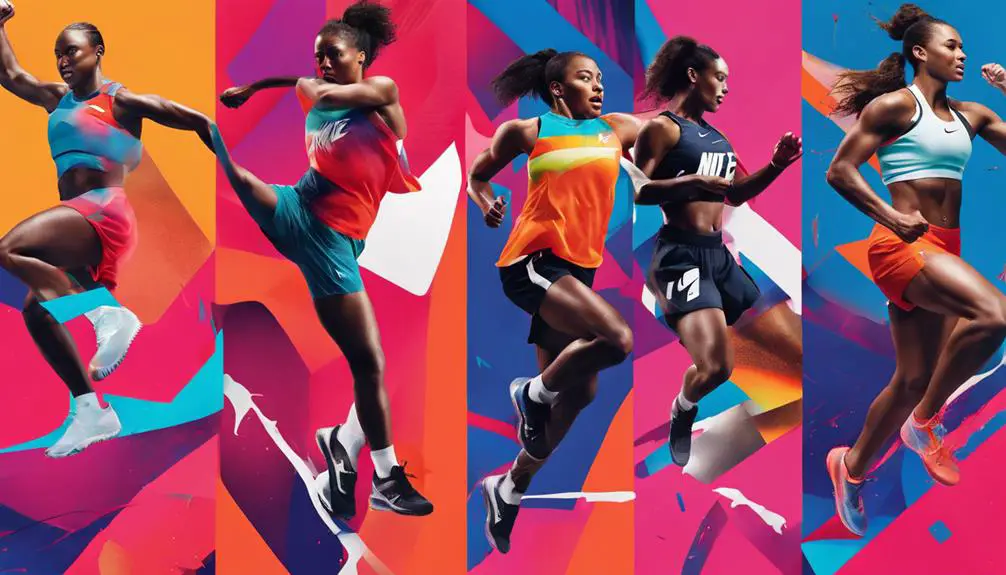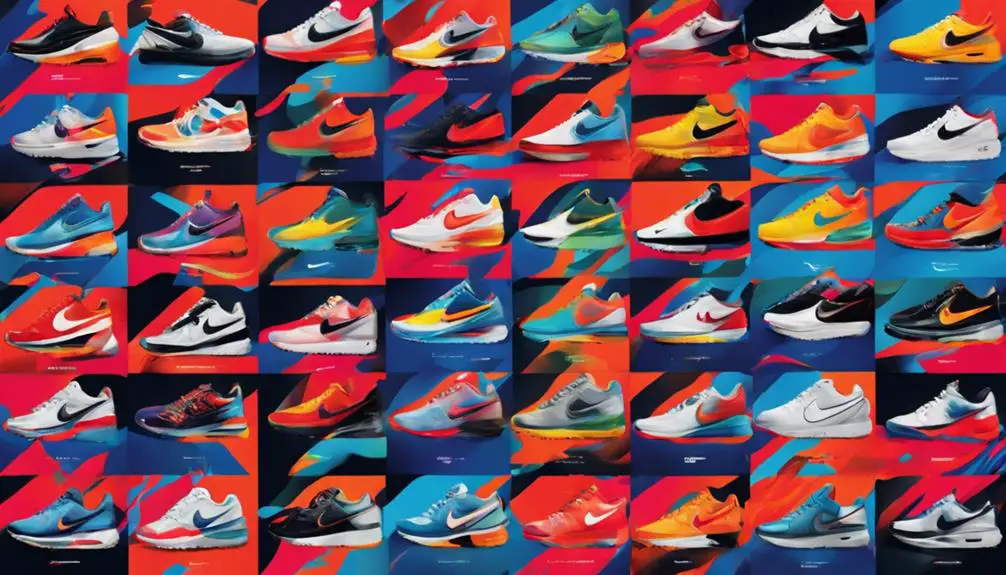The swoosh symbolizes more than just a brand; it represents a relentless pursuit of excellence that transcends sports. You might wonder how Nike's advertising campaigns have managed to resonate so deeply across cultures and generations. From "Just Do It" to "Dream Crazy," these campaigns leverage storytelling that speaks to both the athlete and the everyday individual. What's the secret behind their emotional engagement and cultural relevance? Exploring these iconic campaigns could reveal insights that extend far beyond marketing strategies.
Overview of Nike's Legacy

Nike's legacy is a powerful blend of innovation and inspiration that has shaped the athletic apparel industry for decades. You can't discuss Nike without mentioning its groundbreaking advertising campaigns, starting with the iconic "Just Do It," launched in 1988. This slogan has transcended generations, motivating both elite athletes and everyday individuals to push their limits.
Then there's the "Find Your Greatness" campaign, which debuted during the 2012 London Olympics, skillfully capturing the relatable journey of ordinary people endeavoring for excellence. This not only boosted brand recognition but also helped increase sales considerably.
Nike's knack for emotional storytelling and relatable themes consistently resonates with audiences. Take the "Write the Future" campaign from the 2010 World Cup, which drew over 50 million online views, making it the most shared brand campaign that year. This campaign not only enhanced Nike Football's social media following but also solidified its cultural impact.
Moreover, Nike isn't afraid to tackle societal issues, exemplified by the "Dream Crazy" campaign featuring Colin Kaepernick. This bold move emphasizes personal conviction and social justice, generating widespread media attention and further elevating the brand's status.
Key Campaigns and Their Impact
Throughout its history, numerous key campaigns have greatly shaped Nike's brand identity and market presence. One of the most iconic ads, the "Just Do It" campaign, launched in 1988, became a rallying cry for athletes and everyday people alike, echoing the brand's commitment to performance and motivation. It celebrated determination, contributing to a staggering 31% sales increase during its 30th anniversary, which prominently featured Colin Kaepernick.
This campaign exemplified how powerful messaging can resonate across diverse audiences, much like the vintage Nike designs from the 70s and 80s that showcase quality and style.
Another standout, "Find Your Greatness," aired during the London 2012 Olympics. It broke the mold by emphasizing that greatness isn't just for elite athletes; it's achievable for everyone. This approach generated significant commercial success, reinforcing the Nike brand's commitment to inclusivity.
Then there's "Write the Future," created for the 2010 World Cup. This campaign became the most shared brand initiative that year, amassing over 50 million views and boosting Nike Football's Facebook fan base by an impressive 336%. It showcased the excitement of soccer while connecting fans to the game.
The "I Am Not a Role Model" campaign featuring Charles Barkley in 1993 challenged traditional views on athletes, sparking widespread discussion and expanding Nike's audience.
Emotional Engagement in Advertising

Emotional engagement in advertising plays an essential role in forging strong connections with consumers. When you think of Nike ads, it's hard not to recall powerful campaigns like "Find Your Greatness" and "Dream Crazy." These ads utilize storytelling to tap into personal struggles and triumphs, creating meaningful experiences that resonate deeply with viewers.
By focusing on themes of resilience and vulnerability, Nike not only showcases athletic prowess but also highlights the human experience, which enhances consumer loyalty.
Research indicates that emotionally charged ads can increase viewer recall by 23% compared to non-emotional ones. This statistic reveals just how effective emotional engagement can be in marketing. Consider Nike's "Failure" campaign, which chronicled Michael Jordan's journey through setbacks. His story of perseverance serves as a reminder that vulnerability can inspire greatness, making it relatable to many.
Moreover, emotional connections in advertising greatly influence purchasing decisions. In fact, 55% of consumers report making purchases based on emotional triggers rather than rational analysis. This illustrates that when brands like Nike evoke strong feelings, they not only capture attention but also drive action.
In a world where countless ads compete for your focus, Nike's ability to connect on an emotional level sets them apart. By weaving compelling narratives into their marketing, they create a bond that goes beyond mere transactions, turning customers into lifelong advocates.
Innovations in Nike Marketing
Revolutionizing the landscape of sports marketing, Nike consistently pushes boundaries with innovative strategies that captivate audiences. By leveraging emotional storytelling and powerful imagery, Nike creates connections between their brand and consumers that resonate deeply. You can see this in campaigns like the Find Your Greatness campaign, which celebrated everyday athletes during the London Olympics, showcasing personal achievements that everyone can relate to.
Here are three standout elements of Nike's innovative marketing strategies:
- Cultural Relevance: The Dream Crazy campaign featured Colin Kaepernick, sparking discussions on social justice and aligning brand values with societal issues.
- Digital Platforms: Utilizing viral marketing, Nike's Write the Future campaign generated over 50 million views, demonstrating their knack for engaging audiences through social media.
- Athlete Collaborations: With classic campaigns like Bo Knows, Nike effectively used athlete personas to create relatable content, boosting market share in cross-training shoes.
Moreover, the iconic Just Do It campaign, launched in 1988, unified diverse sports messages, appealing to both elite athletes and casual users, becoming a global phenomenon.
Lessons From Nike's Success

Nike's success offers valuable lessons in effective branding and marketing that any business can learn from. Their iconic "Just Do It" campaign, launched in 1988, demonstrates how relatable messaging can resonate across demographics, driving a remarkable 31% sales spike during its 30th anniversary featuring Colin Kaepernick. This shows you the power of motivation in advertising.
Similarly, the "Find Your Greatness" campaign during the 2012 London Olympics emphasized that greatness isn't exclusive to elite athletes, sparking significant social media buzz and reinforcing accessibility in sports.
Another key takeaway is Nike's strategic use of emotional storytelling. Campaigns like "Failure," featuring Michael Jordan, highlight resilience and the understanding that success often follows setbacks. This connection fosters a deeper bond with your audience.
The "Write the Future" campaign for the 2010 World Cup further exemplifies how high-profile events can enhance brand engagement through creative narratives, generating over 50 million online views.
Additionally, Nike's willingness to embrace risk, as seen with the controversial "Horror, Why Sport?" ad during the 2000 Sydney Olympics, illustrates the potential rewards of pushing creative boundaries in advertising. By leveraging sports stars as role models, Nike cultivates an aspirational image that resonates with consumers.
All these lessons show that effective branding is about more than just selling products—it's about creating a community, inspiring action, and building lasting connections.



